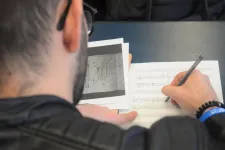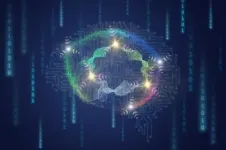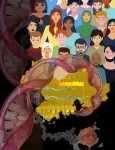(Press-News.org) AMES, Iowa - An unexpected discovery by an Iowa State University researcher suggests that the first humans may have arrived in North America more than 30,000 years ago - nearly 20,000 years earlier than originally thought.
Andrew Somerville, an assistant professor of anthropology in world languages and cultures, says he and his colleagues made the discovery while studying the origins of agriculture in the Tehuacan Valley in Mexico. As part of that work, they wanted to establish a date for the earliest human occupation of the Coxcatlan Cave in the valley, so they obtained radiocarbon dates for several rabbit and deer bones that were collected from the cave in the 1960s as part of the Tehuacan Archaeological-Botanical Project. The dates for the bones suddenly took Somerville and his colleagues in a different direction with their work.
The date ranges for the bone samples from the base of the cave ranged from 33,448 to 28,279 years old. The results are published in the academic journal Latin American Antiquity. Somerville says even though previous studies had not dated items from the bottom of the cave, he was not expecting such old ages. The findings add to the debate over a long-standing theory that the first humans crossed the Bering Land Bridge into the Americas 13,000 years ago.
"We weren't trying to weigh in on this debate or even find really old samples. We were just trying to situate our agricultural study with a firmer timeline," Somerville said. "We were surprised to find these really old dates at the bottom of the cave, and it means that we need to take a closer look at the artifacts recovered from those levels."
Somerville says the findings provide researchers with a better understanding of the chronology of the region. Previous studies relied on charcoal and plant samples, but he says the bones were a better material for dating. However, questions still remain. Most importantly, is there a human link to the bottom layer of the cave where the bones were found?
To answer that question, Somerville and Matthew Hill, ISU associate professor of anthropology, plan to take a closer look at the bone samples for evidence of cut marks that indicate the bones were butchered by a stone tool or human, or thermal alternations that suggest the bones were boiled or roasted over fire. He says the possible stone tools from the early levels of the cave may also yield clues.
"Determining whether the stone artifacts were products of human manufacture or if they were just naturally chipped stones would be one way to get to the bottom of this," Somerville said. "If we can find strong evidence that humans did in fact make and use these tools, that's another way we can move forward."
Year-long journey to even find the bones
Not only was this discovery unexpected, but the process of tracking down the animal bones to take samples was more than Somerville anticipated. The collection of artifacts from the 1960s Tehuacan Archaeological-Botanical Project was distributed to different museums and labs in Mexico and the United States, and it was unclear where the animal bones were sent.
After a year of emails and cold calls, Somerville and his collaborator, Isabel Casar from the National Autonomous University of Mexico, had a potential lead for a lab in Mexico City. The lab director, Joaquin Arroyo-Cabrales, agreed to give Somerville and Casar a tour to help search for the missing collection. The tour proved to be beneficial. Among the countless boxes of artifacts, they found what they were looking for.
"Having spent months trying to locate the bones, we were excited to find them tucked away on the bottom shelf in a dark corner of the lab," Somerville said. "At the time, we felt that was a great discovery, we had no idea it would lead to this."
Once he located the bones, Somerville got permission from the Mexican government to take small samples - about 3/4 inch in length and 1/4 inch in width - from 17 bones (eight rabbits and nine deer) for radiocarbon dating. If closer examination of the bones provides evidence of a human link, Somerville says it will change what we know about the timing and how the first people came to America.
"Pushing the arrival of humans in North America back to over 30,000 years ago would mean that humans were already in North America prior to the period of the Last Glacial Maximum, when the Ice Age was at its absolute worst," Somerville said. "Large parts of North America would have been inhospitable to human populations. The glaciers would have completely blocked any passage over land coming from Alaska and Canada, which means people probably would have had to come to the Americas by boats down the Pacific coast."
INFORMATION:
Isabel Casar, a professor at the National Autonomous University of Mexico, and Joaquín Arroyo-Cabrales, a researcher with the National Institute of Anthropology and History in Mexico, contributed to this research. The work was funded by the National Science Foundation and the Wenner-Gren Foundation.
Key takeaways
The surgical simulator can realistically simulate multiple trauma scenarios at once, compared with traditional simulators that can only simulate one or a limited number of conditions.
Trauma team members who tested the simulator preferred it for its realism, physiologic responses, and feedback.
The benefits of this innovative simulator may be able to extend to other surgical procedures and settings.
CHICAGO (June 1, 2021): Simulators have long been used for training surgeons and surgical teams, but traditional simulator platforms typically have a built-in limitation: they often simulate one or a limited ...
University of South Florida researchers recently developed a novel approach to mitigating electromigration in nanoscale electronic interconnects that are ubiquitous in state-of-the-art integrated circuits. This was achieved by coating copper metal interconnects with hexagonal boron nitride (hBN), an atomically-thin insulating two-dimensional (2D) material that shares a similar structure as the "wonder material" graphene.
Electromigration is the phenomenon in which an electrical current passing through a conductor causes the atomic-scale erosion of the material, eventually resulting in device failure. Conventional semiconductor technology addresses this challenge by using a barrier or liner material, but this takes up precious space on the wafer that could otherwise be used to pack in ...
UNIVERSITY PARK, Pa. -- In 1916 and 1917, a musician and book dealer named Giovanni Concina sold three ornately decorated seventeenth-century songbooks to a library in Venice, Italy. Now, more than 100 years later, a musicologist at Penn State has discovered that the manuscripts are fakes, meticulously crafted to appear old but actually fabricated just prior to their sale to the library. The manuscripts are rare among music forgeries in that the songs are authentic, but the books are counterfeit.
Uncovering deception was not what Marica Tacconi, professor of musicology and associate ...
A new study carried out in pig cells suggests previous infection with swine influenza virus (SIV) can protect against the development of porcine respiratory coronavirus (PRCoV) if there is a zero- or three-day interval between infections.
The findings, published in the peer-reviewed journal Virulence, may also be relevant to influenza and coronavirus infection in humans.
Ju-Yi Peng of the University of Veterinary Medicine Hannover and colleagues used air liquid interface cultures of cells taken from pigs' windpipes to investigate the interactions between the two viruses.
They found that prior infection by swine influenza virus completely inhibited coronavirus infection when the cells were infected ...
Berkeley -- Global land-use changes -- including forest fragmentation, agricultural expansion and concentrated livestock production -- are creating "hot spots" favorable for bats that carry coronaviruses and where conditions are ripe for the diseases to jump from bats to humans, finds an analysis published this week by researchers at the University of California, Berkeley, the Politecnico di Milano (Polytechnic University of Milan) and Massey University of New Zealand.
While the exact origins of the SARS-CoV-2 virus remain unclear, scientists believe that the disease likely emerged when a virus that infects horseshoe bats was able to jump to humans, either ...
Non-alcoholic fatty liver disease (NAFLD) is the most common cause of chronic liver disease worldwide. NAFLD patients are at higher risk of developing Non-alcoholic steatohepatitis (NASH), which causes severe and chronic liver inflammation, fibrosis and liver damage. A patient with NASH is believed to be at high risk for developing a form of liver cancer called hepatocellular carcinoma (HCC).
Apart from lifestyle interventions, there are currently no approved treatments for NASH. A liver transplant is sometimes the only remedy.
While risk factors for NASH (obesity, type-2 diabetes and gene mutations like PNPLA3) and HCC ...
CHAPEL HILL, North Carolina--Researchers have discovered a gene, OTUD7A, that impacts the development of Ewing sarcoma, a bone cancer that occurs mainly in children. They have also identified a compound that shows potential to block OTUD7A protein activity. The finding, by scientists at the University of North Carolina and the Lineberger Comprehensive Cancer Center, appeared online June 1, 2021, in Advanced Science.
About 250 children and young adults are diagnosed with Ewing sarcoma each year in the U.S. About half of those diagnosed will ultimately succumb to the disease, pointing to the need for better therapies.
"Our primary research focus targeted the EWS-FLI1 fusion protein found in about 85 percent of Ewing sarcoma patients," said UNC Lineberger's ...
"SWOG always brings an impressive portfolio of work to the ASCO annual meeting," said SWOG Chair Charles D. Blanke, MD, "and this year I'm particularly excited about the research our investigators are presenting because it includes results that are likely to be practice-changing."
Investigators will present 12 abstracts from SWOG-led or co-led studies and 11 abstracts from studies led by other groups within the National Clinical Trials Network (NCTN).
Results from S1216 will be presented orally by study chair Neeraj Agarwal, MD, of the Huntsman Cancer Institute at the University of Utah. S1216 compared androgen deprivation therapy (ADT) combined with TAK-700 to the standard ...
Quantum computing and quantum sensing have the potential to be vastly more powerful than their classical counterparts. Not only could a fully realized quantum computer take just seconds to solve equations that would take a classical computer thousands of years, but it could have incalculable impacts on areas ranging from biomedical imaging to autonomous driving.
However, the technology isn't quite there yet.
In fact, despite widespread theories about the far-reaching impact of quantum technologies, very few researchers have been able to demonstrate, using the technology available now, that quantum methods have an advantage over their classical counterparts.
In a paper published on June 1 in the journal Physical Review X, University of Arizona researchers experimentally ...
Irvine, CA - June 1, 2021 - A new study analyzing the association between an individual's genetics (genotype) and their observable characteristics resulting from the interaction of genetics and the environment (phenotype), contributes new knowledge to the understanding of human complex traits and diseases.
The study titled, "An atlas of alternative polyadenylation quantitative trait loci (3?aQTLs) contributing to complex trait and disease heritability," was recently published in Nature Genetics. Led by University of California, Irvine professor of ...





